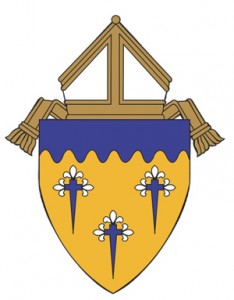Dcn. Gregg Miller
Editor’s note: This is first in a series of six articles on the permanent diaconate in the Diocese of Superior. Dcn. Miller serves St. Patrick, Hudson.
Around the year 1,000 AD, the ordained clergy position of deacon was discontinued. Not until Vatican II in the 1960s did the role of permanent deacon reemerge. Since then, permanent deacons, ordained in the succession of St. Peter, have served in parishes around the world and in the Diocese of Superior.
You are probably most familiar with a permanent deacon dressed in a white alb with a stole draped from the left shoulder, across the chest to the right hip. Your usual encounter will be at Mass, maybe preaching at Mass or presiding at the Stations of the Cross or other such devotions. But just what is a deacon? When and how did the diaconate start? What ranking in clergy, compared to priest or bishop, are deacons?
Today, there are 65 deacons in the Diocese of Superior, with 54 in active ministry and 11 retired but still serving from time to time. Ordained men, called permanent deacons, serve throughout the Diocese of Superior. Over the next few issues, six articles will be printed, including five more by fellow deacons, that will unveil their calling, discernment, formation, ordination to permanent deacon and the vast variety of ministries they perform, much of which is behind the scenes.
To read the Scriptural source for the creation of deacons, go to Acts of the Apostles 6: 1-7 in the Bible. Note that St. Stephen is the patron saint of deacons and also the first martyr of the church.
Although deacons have been around since the time of St. Peter, about the year 1,000 AD, the permanent diaconate faded away. During Second Vatican Council – June 16, 1967, to be exact – Pope Paul VI implemented the council’s decision to re-instate permanent deacons.
The role of modern-day deacons has not changed: 1) preach the Gospel; and 2) be of service to our bishop, our pastor, our fellow parishioners and to God’s people everywhere. The Office of Deacon is the first step in clergy ranking: deacon, priest, bishop.
Most eloquently stated by Pope Francis in June 2021:”Deacons are the guardians of service in the church” (Vatican News 19, June 2021). With the “new church,” the Apostles, deep in prayer, organization and evangelizing, the needs of many converts were neglected, especially the “widowed Hellenist Jews were being overlooked” (Acts 6).
The Apostles said “Brothers, select from among you seven reputable men, filled with Spirit and wisdom, whom we shall appoint to this task (of serving those in need)”. The first seven deacons were ordained (appointed). Make special note here: The deacon is not ordained for priesthood, he is ordained for service. A modern-day deacon must always prioritize his life: God first, attention to family second, making their own income, then dedication to the office of deacon and a life of service. How about a mention in this area about the fact that a deacon, unlike a priest, can be married?
Pope Francis has stated; “Please let us remember that for the disciples of Jesus, to love is to serve and to serve is to reign. Power lies in service, not in anything else. They (deacons) are the guardians of true ‘power’ in the church, so that no one goes beyond the power of service” (Vatican News 19, June 2021).
So, why did Vatican II reinstate the diaconate? For the same reason the church did 2,000 years ago. To serve the people of God more fully, many hands were needed. Not just more volunteers or volunteer hours – more men to preach, to run specific ministries, be an ordained liaison between priests and the laity. Men of good character instructed in theology, church history, preaching, parish management and Scripture to be an extension of the priest’s duties and roles within parish life. The late Bishop Raphael Fliss approved that deacons would serve the people of God in the Diocese of Superior. But there was no training curriculum. One would need to be created.

